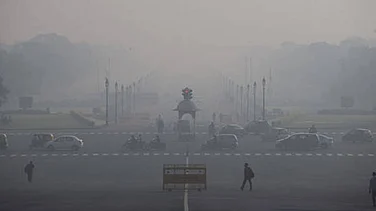The Indian Space Research Organisation (ISRO) successfully launched an earth observation satellite, on board the third and final development flight of the SSLV-03 (Small Satellite Launch Vehicle) on Friday.
The launch took place at 9:17 am from the first launch pad of the Satish Dhawan Space Centre in Andhra Pradesh's Sriharikota.
The space agency shared that the SSLV-D3 placed EOS-08 precisely into the orbit, marking the successful completion of ISRO/DOS's SSLV Development Project.
WATCH:
The SSLV-D3-EOS-08 mission comes after the successful launch of the second test flight of the Small Satellite Launch Vehicle (SSLV-D2-EOS-07) in February, 2023.
This mission is the third mission of 2024 for the space agency after the successful PSLV-C58/XpoSat mission in January and GSLV-F14/INSAT-3DS missions in February.
Sharing an update about the mission, ISRO had earlier posted on X, "Six-and-a-half-hour countdown leading to the launch commenced at 02:47 hrs IST."
The smallest SSLV rocket, about 34 metres in height, was earlier planned to be launched on August 15 at 9:17 am but, was later rescheduled to August 16 at 9:19 am.
The mission is a boost to the commercial branch of ISRO -- NewSpace India Ltd -- to take up commercial launches using Small Satellite Launch Vehicles with the industry.
"With technology transfer, the Indian industry and @NSIL_India will now produce SSLV for commercial missions," ISRO said in an X post shortly after the lift-off.
Prime Minister Narendra Modi congratulated ISRO for this "remarkable milestone".
In a post on microblogging site X, PM Modi said, "Congratulations to our scientists and industry for this feat. It is a matter of immense joy that India now has a new launch vehicle."
"The cost-effective SSLV will play an important role in space missions and will also encourage private industry. My best wishes to @isro, @INSPACeIND, @NSIL_India and the entire space industry.
Andhra Pradesh Chief Minister N Chandrababu Naidu congratulated ISRO on successfully launching the SSLV-D3-EOS-08 and termed the milestone as an achievement which strengthens the nation's small satellites capability.
"A moment of glory for India's space prowess! Congratulations to ISRO on the successful launch of SSLV-D3-EOS-08 from Sriharikota today," Naidu said in a post on X.
He further said, "This milestone achievement strengthens India's small satellite capabilities and empowers NewSpace India Ltd for future commercial launches. I extend my best wishes to Team ISRO for their future endeavours."
The space agency said that the primary objectives of the EOS-08 mission include designing and developing a microsatellite, creating payload instruments compatible with the microsatellite bus, and incorporating new technologies required for future operational satellites.
With EOS-08, ISRO completes the developmental flight of the smallest rocket which can carry satellites weighing up to 500 kg and can place them into Low Earth Orbit 9of up to 500 km above Earth).
The EOS-08 -- built on the Microsat/IMS-1 bus -- carries three payloads, namely the Electro Optical Infrared Payload (EOIR), Global Navigation Satellite System-Reflectometry payload (GNSS-R) and SiC UV Dosimeter.
Of these, the EOIR is designed to capture images in the Mid-Wave IR (MIR) and Long-Wave IR (LWIR) bands, both during the day and night, for applications such as satellite-based surveillance, disaster monitoring, environmental monitoring, fire detection, volcanic activity observation, and industrial and power plant disaster monitoring.
Meanwhile, the GNSS-R payload shows the capability of using GNSS-R-based remote sensing for application such as ocean surface wind analysis, soil moisture assessment, cryosphere studies over the Himalayan region, flood detection, and inland waterbody detection.
Lastly, the third payload -- SiC UV Dosimeter -- monitors UV irradiance at the viewpoint of the Crew Module in the Gaganyaan Mission and serves as a high-dose alarm sensor for gamma radiation.
With a mission life of one year, the spacecraft mission configuration is set to operate in a Circular Low Earth Orbit (LEO) at an altitude of 475 km with an inclination of 37.4 degrees.
















